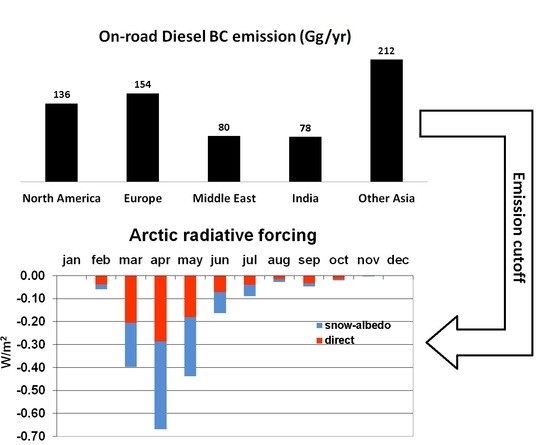A Modelling Study of the Impact of On-Road Diesel Emissions on Arctic Black Carbon and Solar Radiation Transfer
Abstract
:1. Introduction
2. Experimental Section
2.1. The Model
2.2. BC Radiative Properties
2.3. BC Emissions

2.4. Numerical Experiment Setup
| Δτ (%) | |
|---|---|
| Europe | 33 |
| Russia | 32 |
| Asia | 27 |
| North America | 8 |
3. Results and Discussion
3.1. Evaluation of Model Results with Observations
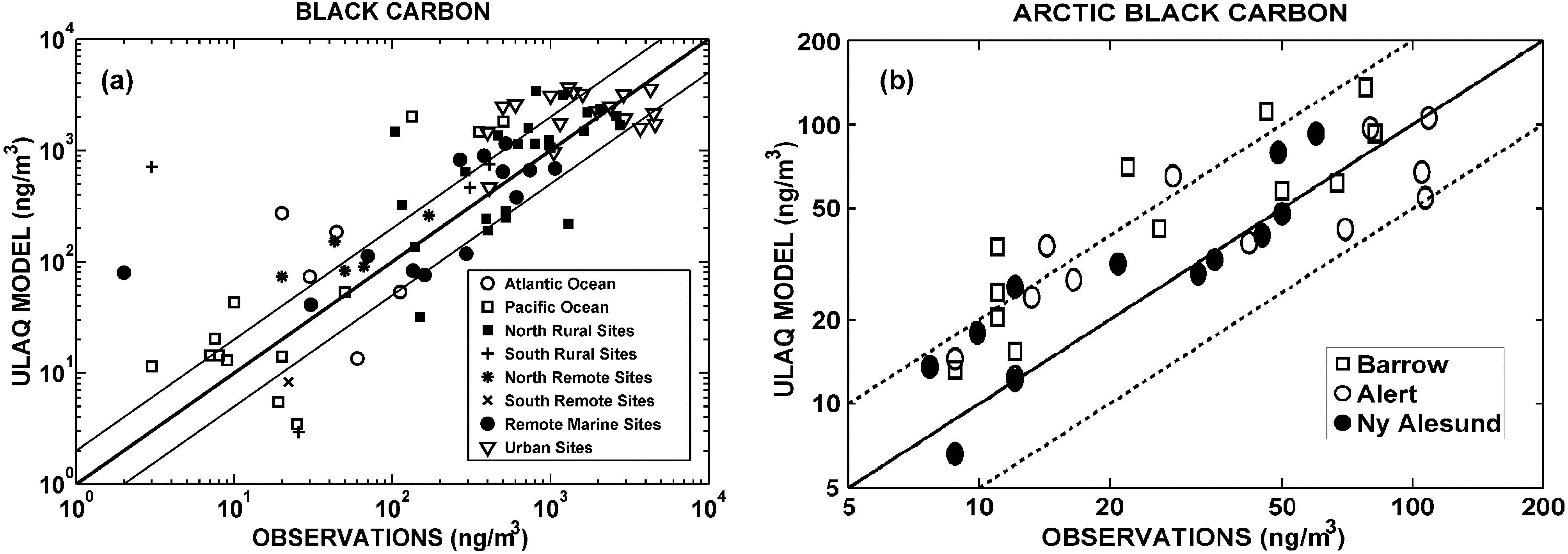

3.2. Discussion of Model Results
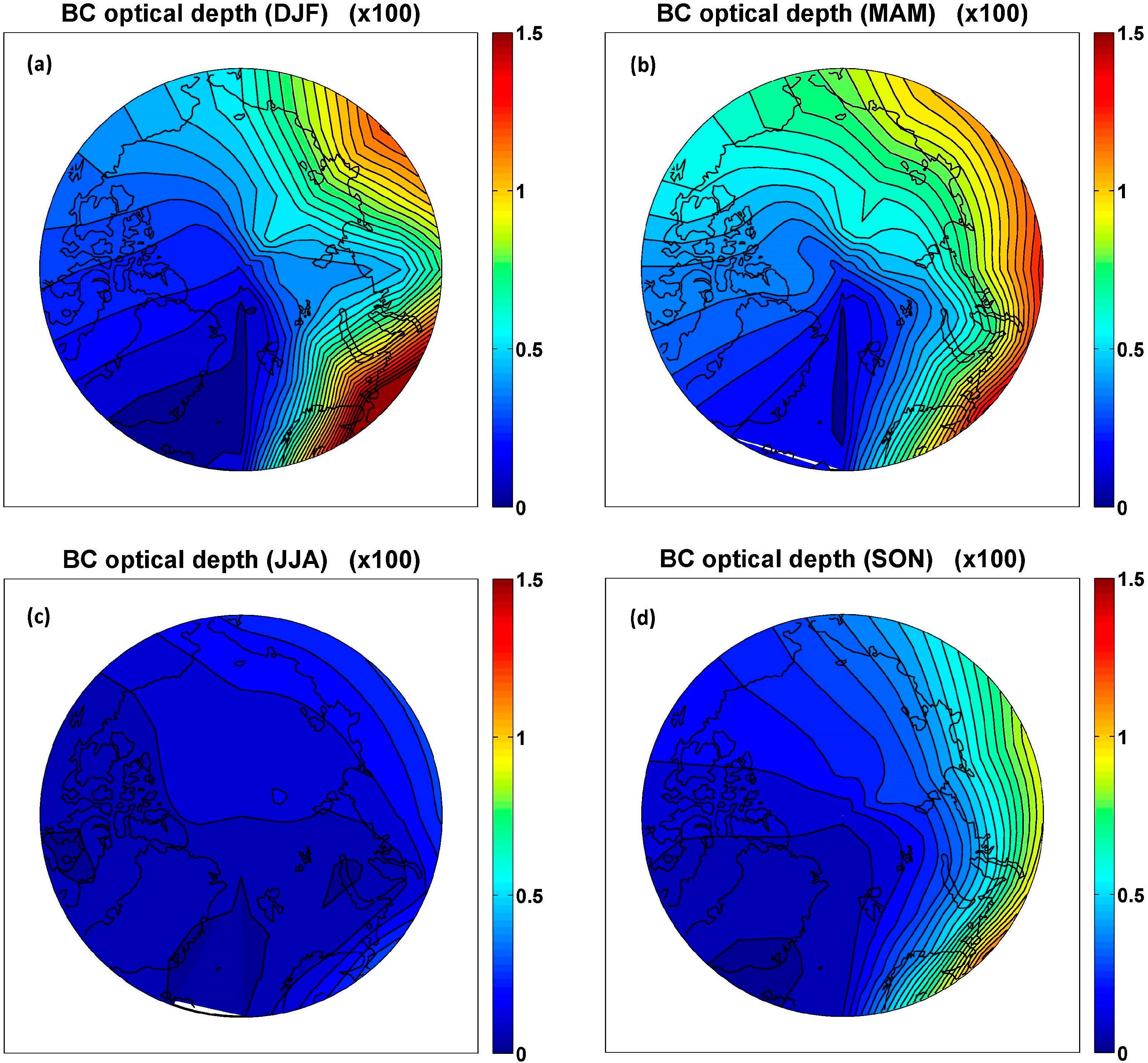
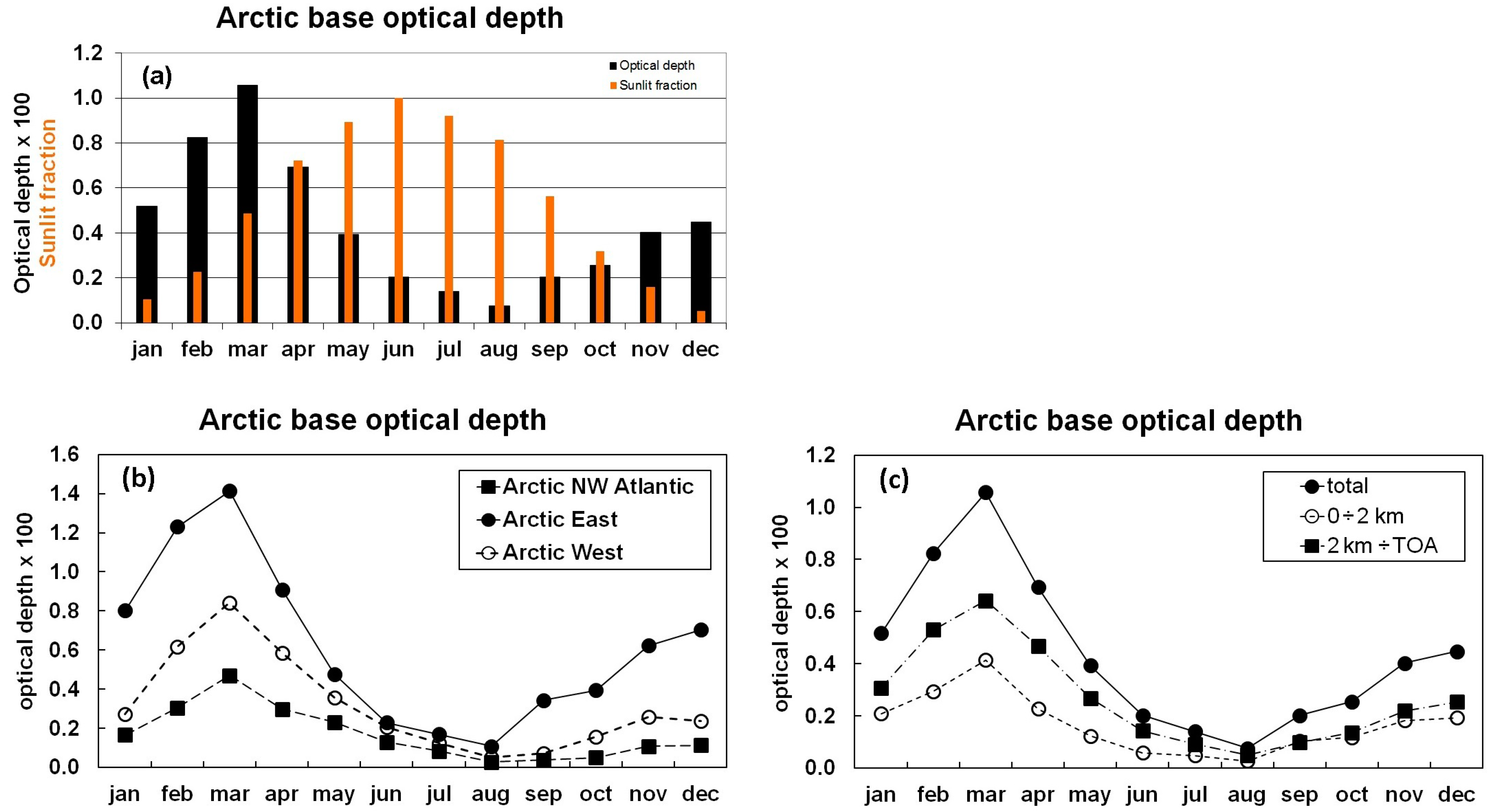

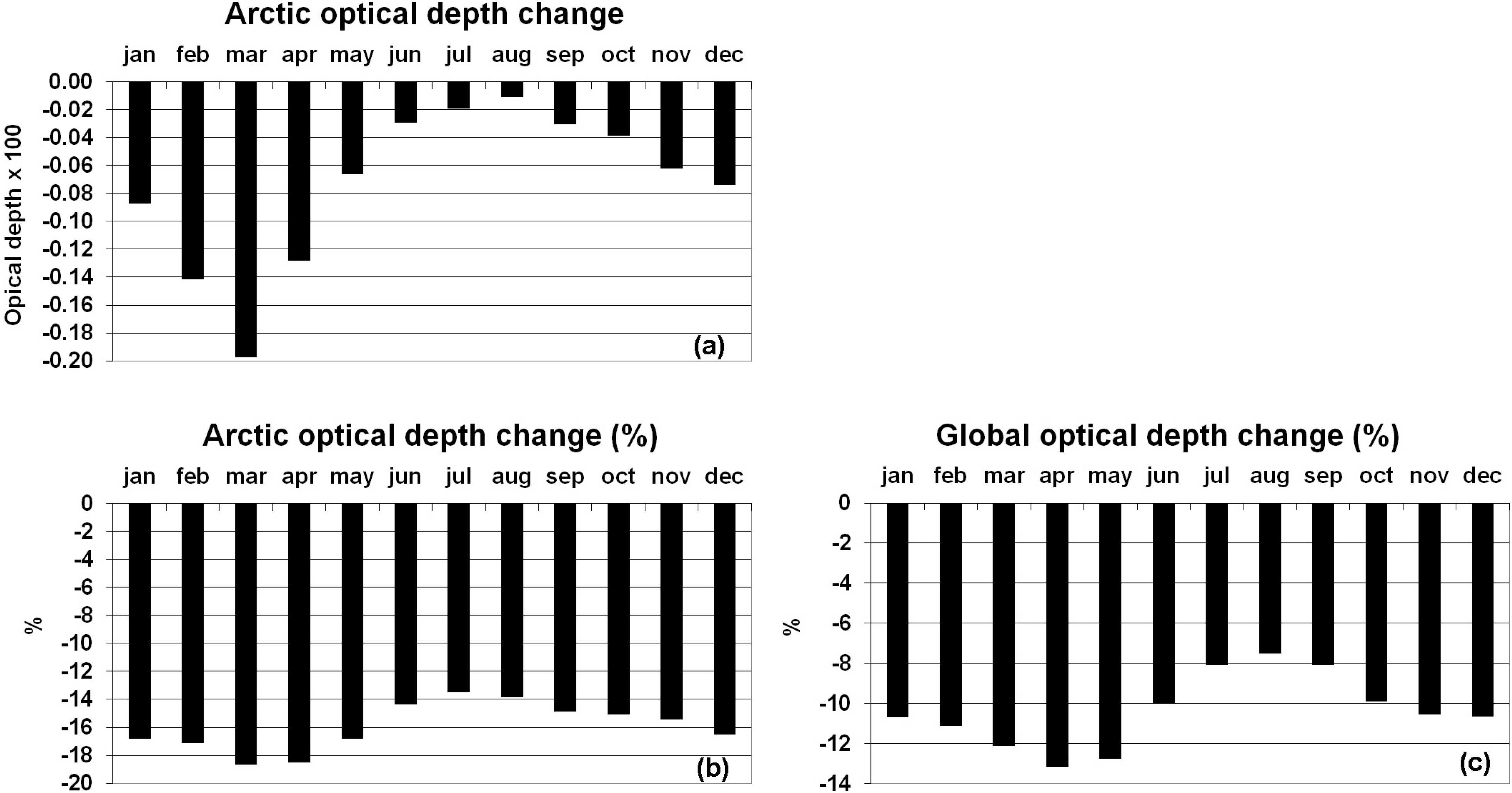
3.3. Radiative Calculations

| Δτ (×100) | Direct RF (W∙m−2) | Direct NRF (W/m2/Δτ) | Snow-Albedo RF (W∙m−2) | BC in Arctic Snow (ppbm) | Total RF (W∙m−2) | Total NRF (W/m2/Δτ) | |
|---|---|---|---|---|---|---|---|
| Arctic annual | −0.074 | −0.074 | 110 | −0.086 | 6.0 ± 3.6 | −0.16 | 240 |
| Global annual | −0.048 | −0.054 | 115 | −0.010 | −0.064 | 130 | |
| Arctic MAM | −0.13 | −0.22 | 200 | −0.28 | 10.5 ± 5.5 | −0.50 | 460 |
| Global MAM | −0.055 | −0.079 | 145 | −0.023 | −0.10 | 185 |
| Pressure Layer (hPa) | Direct NRF Clear Sky (W/m2/Δτ) | Direct NRF Total Sky (W/m2/Δτ) |
|---|---|---|
| 334–284 | 87 | 99 |
| 393–334 | 207 | 220 |
| 463–393 | 203 | 215 |
| 544–463 | 198 | 210 |
| 640–544 | 193 | 203 |
| 753–640 | 187 | 184 |
| 885–753 | 182 | 171 |
| 1000–885 | 176 | 164 |
| τ (×100) | Direct RF (W∙m−2) | Snow-Albedo RF (W∙m−2) | BC in Arctic Snow (ppbm) | Total RF (W∙m−2) | |
|---|---|---|---|---|---|
| Arctic annual | 0.45 | 0.43 | 0.51 | 36 ± 22 | 0.94 |
| Global annual | 0.46 | 0.46 | 0.054 | 0.51 | |
| Arctic MAM | 0.72 | 1.25 | 1.58 | 58 ± 31 | 2.83 |
| Global MAM | 0.45 | 0.66 | 0.13 | 0.79 |


4. Conclusions
Acknowledgments
Author Contributions
Conflicts of Interest
References
- Uherek, E.; Halenka, T.; Borken-Kleefeld, J.; Balkanski, Y.; Berntsen, T.; Borrego, C.; Gauss, M.; Hoor, P.; Juda-Rezler, K.; Lelieveld, J.; et al. Transport impacts on atmosphere and climate: Land transport. Atmos. Env. 2010, 44, 4772–4816. [Google Scholar] [CrossRef]
- Shine, K.; Forster, P.M. The effect of human activity on radiative forcing of climate change: A review of recent developments. Glob. Planet. Chang. 1999, 20, 205–225. [Google Scholar] [CrossRef]
- Intergovernmental Panel for Climate Change (IPCC). Climate change 2013. In The Physical Science Basis; Stocker, T.F., Qin, D., Plattner, G.-K., Tignor, M.M.B., Allen, S.K., Boschung, J., Nauels, A., Xia, Y., Bex, V., Midgley, P.M., Eds.; Cambridge University Press: Cambridge, UK, 2013; Chapter 7. [Google Scholar]
- Fuller, K.A.; Malm, W.C.; Kreidenweis, S.M. Effects of mixing on extinction by carbonaceous particles. J. Geophys. Res. 1999, 104, 15941–15954. [Google Scholar] [CrossRef]
- Saleh, R.; Robinson, E.S.; Tkacik, D.S.; Ahern, A.T.; Liu, S.; Aiken, A.C.; Sullivan, R.C.; Presto, A.A.; Dubey, M.K.; Yokelson, R.J.; et al. Brownness of organics in aerosols from biomass burning linked to their black carbon content. Nat. Geosci. 2014, 7, 647–650. [Google Scholar] [CrossRef]
- Bond, T.C.; Doherty, S.J.; Fahey, D.W.; Forster, P.M.; Berntsen, T.; DeAngelo, B.J.; Flanner, M.G.; Ghan, S.; Kärcher, B.; Koch, D.; et al. Bounding the role of black carbon in the climate system: A scientific assessment. J. Geophys. Res. 2013, 118, 5380–5552. [Google Scholar]
- Cohen, J.B.; Wang, C. Estimating global black carbon emissions using a top-down Kalman filter approach. J. Geophys. Res. 2013. [Google Scholar] [CrossRef]
- Brandt, E.B.; Kovacic, M.B.; Lee, G.B.; Gibson, A.M.; Acciani, T.H.; Thomas, H.; Le Cras, T.D.; Ryan, P.H.; Budelsky, A.L.; Hershey, G.K.K. Diesel exhaust particle induction of IL-17A contributes to severe asthma. J. Allergy Clin. Immunol. 2013, 132, 1194–1201. [Google Scholar] [CrossRef] [PubMed]
- Suglia, S.F.; Gryparis, A.; Wright, R.O.; Schwartz, J.; Wright, R.J. Association of black carbon with cognition among children in a prospective birth cohort study. Am. J. Epidemiol. 2008, 167, 280–286. [Google Scholar] [CrossRef] [PubMed]
- McCracken, J.; Baccarelli, A.; Hoxha, M.; Dioni, L.; Melly, S.; Coull, B.; Suh, H.; Vokonas, P.; Schwartz, J. Annual ambient black carbon associated with shorter telomeres in elderly men: Veterans Affairs Normative Aging Study. Environ. Health Perspect. 2010, 118, 1564–1570. [Google Scholar] [CrossRef] [PubMed]
- Riddle, S.G.; Robert, M.; Jakober, C.A.; Hannigan, M.P.; Kleeman, M.J. Size-Resolved source apportionment of airborne particle mass in a roadside environment. Environ. Sci. Technol. 2008, 42, 6580–6586. [Google Scholar] [CrossRef] [PubMed]
- Twigg, M.W. Progress and future challenges in controlling automotive exhaust gas emissions. Appl. Catal. B Environ. 2007, 70, 2–15. [Google Scholar] [CrossRef]
- Bond, T.C.; Streets, D.G.; Yarber, K.F.; Nelson, S.M.; Woo, J.-H.; Klimont, Z. A technology-based global inventory of black and organic carbon emissions from combustion. J. Geophys. Res. 2004, 109, D14203. [Google Scholar] [CrossRef]
- Environmental Protection Agency (EPA). Report to Congress on Black Carbon; EPA-450/R-12–001; Department of the Interior, Environment, and Related Agencies: Research Triangle Park, NC, USA, 2012. [Google Scholar]
- Kopp, R.E.; Mauzeralla, D.L. Assessing the climatic benefits of black carbon mitigation. PNAS 2010, 107, 11703–11708. [Google Scholar] [CrossRef] [PubMed]
- World Meteorological Organization (WMO). Integrated Assessment of Black Carbon and Tropospheric Ozone; WMO: Geneva, Switzerland, 2011. [Google Scholar]
- Pitari, G.; Di Carlo, P.; Coppari, E.; de Luca, N.; Di Genova, G.; Iarlori, M.; Pietropaolo, E.; Rizi, V.; Tuccella, P. Aerosol measurements in central Italy: Impact of local sources and large scale transport resolved by LIDAR. J. Atmos. Solar-Terr. Phys. 2013, 92, 116–123. [Google Scholar] [CrossRef]
- Koch, D.; Hansen, J. Distant origins of Arctic black carbon: A Goddard Institute for Space Studies Model E experiment. J. Geophys. Res. 2005, 110, D04204. [Google Scholar] [CrossRef]
- Jiao, C.; Flanner, M.G.; Balkanski, Y.; Bauer, S.E.; Bellouin, N.; Berntsen, T.K.; Bian, H.; Carslaw, K.S.; Chin, M.; De Luca, N.; et al. An AeroCom assessment of black carbon in Arctic snow and sea ice. Amos. Chem. Phys. 2014, 14, 2399–2417. [Google Scholar]
- Flanner, M.G. Arctic climate sensitivity to local black carbon. J. Geophys. Res. 2013, 118, 1840–1851. [Google Scholar]
- Hansen, J.; Nazarenko, L. Soot climate forcing via snow and ice albedos. PNAS 2004, 101, 423–428. [Google Scholar] [CrossRef] [PubMed]
- Schulz, M.C.; Textor, S.; Kinne, Y.; Balkanski, S.; Bauer, T.; Berntsen, T.; Berglen, O.; Boucher, F.; Dentener, S.; Guibert, I.S.A.; et al. Radiative forcing by aerosols as derived from the AeroCom present-day and pre-industrial simulations. Atmos. Chem. Phys. 2006, 6, 5225–5246. [Google Scholar] [CrossRef]
- Pitari, G.; Mancini, E.; Rizi, V.; Shindell, D.T. Impact of future climate and emission changes on stratospheric aerosols and ozone. J. Atmos. Sci. 2002, 59, 414–440. [Google Scholar] [CrossRef]
- Eyring, V.; Butchart, N.; Waugh, D.W.; Akiyoshi, H.; Austin, J.; Bekki, S.; Bodeker, G.E.; Boville, B.A.; Brühl, C.; Chipperfield, M.P.; et al. Assessment of temperature, trace species, and ozone in chemistry-climate model simulation of the recent past. J. Geophys. Res. 2006, 111, D22308. [Google Scholar] [CrossRef]
- Morgenstern, O.; Giorgetta, M.A.; Shibata, K.; Eyring, V.; Waugh, D.; Shepherd, T.G.; Akiyoshi, H.; Austin, J.; Baumgärtner, A.; Bekki, S.; et al. A review of CCMVal-2 models and simulations. J. Geophys. Res. 2010. [Google Scholar] [CrossRef]
- Kärcher, B.; Lohmann, U. A parameterization of cirrus cloud formation: Homogeneous freezing of supercooled aerosols. J. Geophys. Res. 2002. [Google Scholar] [CrossRef]
- Kärcher, B.; Lohmann, U. A parameterization of cirrus cloud formation: Homogeneous freezing including effects of aerosol size. J. Geophys. Res. 2002. [Google Scholar] [CrossRef]
- Pitari, G.; Aquila, V.; Kravitz, B.; Robock, A.; Watanabe, S.; Cionni, I.; de Luca, N.; Di Genova, G.; Mancini, E.; Tilmes, S. Stratospheric ozone response to sulfate geoengineering: Results from the Geoengineering Model Intercomparison Project (GeoMIP). J. Geophys. Res. 2014, 119, 2629–2653. [Google Scholar]
- Penner, J.E. Carbonaceous aerosols influencing atmospheric radiation: Black carbon. In Aerosol Forcing of Climate; Charlson, R.J., Heintzenberg, J., Eds.; Wiley: Chichester, UK, 1995; pp. 91–108. [Google Scholar]
- Koch, D.; Schulz, M.; Kinne, S.; McNaughton, C.; Spackman, J.R.; Bond, T.C.; Balkanski, Y.; Bauer, S.; Berntsen, T.; Boucher, O.; et al. Evaluation of black carbon estimations in Global Aerosol Models. Atmos. Chem. Phys. 2009, 9, 9001–9026. [Google Scholar] [CrossRef]
- Lamarque, J.F.; Kyle, G.P.; Meinshausen, M.; Riahi, K.; Smith, S.J.; van Vuuren, D.P.; Conley, A.J.; Vitt, F. Global and regional evolution of short-lived radiatively-active gases and aerosols in the representative concentration pathways. Clim. Chang. 2011, 109, 191–212. [Google Scholar] [CrossRef]
- Textor, C.; Schulz, M.; Guibert, S.; Kinne, S.; Balkanski, Y.; Bauer, S.; Berntsen, T.; Berglen, T.; Boucher, O.; Chin, M.; et al. Analysis and quantification of the diversities of aerosol life cycles within AEROCOM. Atmos. Chem. Phys. 2006, 6, 1777–1813. [Google Scholar] [CrossRef]
- Kinne, S.; Schulz, M.; Textor, C.; Guibert, S.; Balkanski, Y.; Bauer, S.E.; Berntsen, T.; Berglen, T.; Boucher, O.; Chin, M.; et al. An AeroCom initial assessment—Optical properties in aerosol component modules of global models. Atmos. Chem. Phys. 2006, 6, 1815–1834. [Google Scholar] [CrossRef]
- Penner, J.; Hegg, D.; Andreae, M.; Leaitch, D.; Pitari, G.; Annegarn, H.; Murphy, D.; Nganga, J.; Barrie, L.; Feichter, H. Chapter 5: Aerosols and indirect cloud effects. In Climate Change 2001—IPCC Third Assessment Report; Houghton, J., Ding, Y., Griggs, D.J., Noguer, M., van der Linden, P.J., Dai, X., Maskell, K., Johnson, C.A., Eds.; Cambridge University Press: Cambridge, UK, 2001; pp. 289–348. [Google Scholar]
- Penner, J.E.; Zhang, S.Y.; Chin, M.; Chuang, C.C.; Feichter, J.; Feng, Y.; Geogdzhayev, I.V.; Ginoux, P.; Herzog, M.; Higurashi, A.; et al. A comparison of model- and satellite-derived optical depth and reflectivity. J. Atmos. Sci. 2001, 59, 441–460. [Google Scholar] [CrossRef]
- Kinne, S.; Lohmann, U.; Feichter, J.; Schulz, M.; Timmreck, C.; Ghan, S.; Easter, R.; Chin, M.; Ginoux, P.; Takemura, T.; et al. Monthly averages of aerosol properties: A global comparison among models, satellite data and AERONET ground data. J. Geophys. Res. 2003. [Google Scholar] [CrossRef]
- Textor, C.; Schulz, M.; Guibert, S.; Kinne, S.; Balkanski, Y.; Bauer, S.; Berntsen, T.; Berglen, T.; Boucher, O.; Chin, M.; et al. The effect of harmonized emissions on aerosol properties in global models—An AeroCom experiment. Atmos. Chem. Phys. 2007, 7, 4489–4501. [Google Scholar] [CrossRef]
- Koch, D.; Schulz, M.; Kinne, S.; McNaughton, C.; Spackman, J.R.; Balkanski, Y.; Bauer, S.; Berntsen, T.; Bond, T.C.; Boucher, O.; et al. Corrigendum to “Evaluation of Black Carbon Estimations in Global Aerosol Models”. published in Atmos. Chem. Phys., 9, 9001–9026, 2009. Atmos. Chem. Phys. 2010, 10, 79–81. [Google Scholar] [CrossRef]
- Randles, C.A.; Kinne, S.; Myhre, G.; Schulz, M.; Stier, P.; Fischer, J.; Doppler, L.; Highwood, E.; Ryder, C.; Harris, B.; et al. Intercomparison of shortwave radiative transfer schemes in global aerosol modeling: Results from the AeroCom Radiative Transfer Experiment. Atmos. Chem. Phys. 2013, 13, 2347–2379. [Google Scholar] [CrossRef] [Green Version]
- Chou, M.D.; Suarez, M.J. A Solar Radiation Parameterization for Atmospheric Studies; NASA Tech. Rep. TM-1999–104606; NASA Goddard Space Flight Cent.: Greenbelt, MD, USA, 1999. [Google Scholar]
- Mishchenko, M.I.; Travis, L.D.; Lacis, A.A. Scattering, Absorption, and Emission of Light by Small Particles; Cambridge University Press: Cambridge, UK, 2002. [Google Scholar]
- Chipperfield, M.P.; Liang, Q.; Strahan, S.E.; Morgenstern, O.; Dhomse, S.S.; Abraham, N.L.; Archibald, A.T.; Bekki, S.; Braesicke, P.; Di Genova, G.; et al. Multi-model estimates of atmospheric lifetimes of long-lived ozone-depleting substances: Present and future. J. Geophys. Res. 2014, 119, 2555–2573. [Google Scholar]
- Schwarz, J.P.; Spackman, J.R.; Gao, R.S.; Watts, L.A.; Stier, P.; Schulz, M.; Davis, S.M.; Wofsy, S.C.; Fahey, D.W. Global-scale black carbon profiles observed in the remote atmosphere and compared to models. Geophys. Res. Lett. 2010. [Google Scholar] [CrossRef]
- Pueschel, R.F.; Kinne, S.A. Physical and radiative rroperties of Arctic atmospheric aerosols. Sci. Tot. Env. 1995, 160/161, 811–824. [Google Scholar] [CrossRef]
- Liousse, C.; Penner, J.E.; Chuang, C.; Walton, J.J.; Eddleman, H.; Cachier, H. A global three-dimensional model study of carbonaceous aerosols. J. Geophys. Res. 1996, 101, 19411–19432. [Google Scholar] [CrossRef]
- Quinn, P.K.; Stohl, A.; Arneth, A.; Berntsen, T.; Burkhart, J.F.; Christensen, J.; Flanner, M.; Kupiainen, K.; Lihavainen, H.; Shepherd, M.; et al. The Impact of Black Carbon on Arctic Climate; Arctic Monitoring and Assessment Programme (AMAP): Oslo, Norway, 2011. [Google Scholar]
- Sharma, S.; Ogren, J.A.; Jefferson, A.; Eleftheriadis, K.; Chan, E.; Quinn, P.K.; Burkhart, J.F. Black Carbon in the Arctic, Arctic Report Card 2013. Available online: http://www.arctic.noaa.gov/reportcard/ (accessed on 12 October 2014).
- Rosen, H.; Hansen, A.D.A.; Novakov, T. Role of graphitic carbon particles in radiative transfer in the Arctic haze. Sci. Total Environ. 1984, 36, 103–110. [Google Scholar] [CrossRef]
- Samset, B.H.; Myhre, G.; Herber, A.; Kondo, Y.; Li, S.-M.; Moteki, N.; Koike, M.; Oshima, N.; Schwarz, J.P.; Balkanski, Y.; et al. Modelled black carbon radiative forcing and atmospheric lifetime in AeroCom Phase II constrained by aircraft observations. Atmos. Chem. Phys. 2014, 14, 12465–12477. [Google Scholar] [CrossRef]
- Lee, Y.H.; Lamarque, J.-F.; Flanner, M.G.; Jiao, C.; Shindell, D.T.; Berntsen, T.; Bisiaux, M.M.; Cao, J.; Collins, W.J.; Curran, M.; et al. Evaluation of preindustrial to present-day black carbon and its albedo forcing from Atmospheric Chemistry and Climate Model Intercomparison Project (ACCMIP). Atmos. Chem. Phys. 2013, 13, 2607–2634. [Google Scholar] [CrossRef]
- Cross, E.S.; Onasch, T.B.; Ahern, A.; Wrobel, W.; Slowik, J.G.; Olfert, J.; Lack, D.A.; Massoli, P.; Cappa, C.D.; Schwarz, J.P.; et al. Soot particle studies—instrument inter-comparison—project overview. Aerosol Sci. Technol. 2010, 44, 592–611. [Google Scholar] [CrossRef]
- Søvde, O.A.; Skowron, A.; Iachetti, D.; Lim, L.; Owen, B.; Hodnebrog, Ø.; Di Genova, G.; Pitari, G.; Lee, D.S.; Myhre, G.; et al. Aircraft emission mitigation by changing route altitude: A multi-model estimate of aircraft NOx emission impact on O3 photochemistry. Atmos. Env. 2014. [Google Scholar] [CrossRef]
- Hendricks, J.; Kärcher, B.; Lohmann, U.; Ponater, M. Do aircraft black carbon emissions affect cirrus clouds on the global scale? Geophys. Res. Lett. 2005, 32, L12814. [Google Scholar] [CrossRef]
- Barrie, L.A. Arctic air pollution: An overview of current knowledge. Atmos. Environ. 1986, 20, 643–663. [Google Scholar] [CrossRef]
- Iversen, T.; Joranger, E. Arctic air pollution and large scale atmospheric flows. Atmos. Environ. 1985, 19, 2099–2108. [Google Scholar] [CrossRef]
- Breider, T.J.; Mickley, L.J.; Jacob, D.J.; Wang, Q.; Fisher, J.A.; Chang, R.Y.-W.; Alexander, B. Annual distributions and sources of Arctic aerosol components, aerosol optical depth, and aerosol absorption. J. Geophys. Res. 2014, 119, 4107–4124. [Google Scholar]
- Samset, B.H.; Myhre, G.; Schulz, M.; Balkanski, Y.; Bauer, S.; Berntsen, T.K.; Bian, H.; Bellouin, N.; Diehl, T.; Easter, R.C.; et al. Black carbon vertical profiles strongly affect its radiative forcing uncertainty. Atmos. Chem. Phys. 2013, 13, 2423–2434. [Google Scholar] [CrossRef]
- Hansen, J.; Sato, M.; Ruedy, R.; Nazarenko, L.; Lacis, A.; Schmidt, G.A.; Russell, G.; Aleinov, I.; Bauer, M.; Bauer, S.; et al. Efficacy of climate forcings. J. Geophys. Res. 2005, 110, D18104. [Google Scholar] [CrossRef]
- Hansen, J.; Sato, M.; Ruedy, R.; Kharecha, P.; Lacis, A.; Miller, R.L.; Nazarenko, L.; Lo, K.; Schmidt, G.A.; Russell, G.; et al. Climate simulations for 1880–2003 with GISS ModelE. Clim. Dyn. 2007, 29, 661–696. [Google Scholar] [CrossRef]
- Flanner, M.G.; Zender, C.S.; Randerson, J.T.; Rasch, P.J. Present-day climate forcing and response from black carbon in snow. J. Geophys. Res. 2007, 112, D11202. [Google Scholar] [CrossRef]
- Walsh, M.P. On and off road policy strategies. In Proceedings of the ICCT International Workshop on Black Carbon, London, UK, 5 January 2009.
© 2015 by the authors; licensee MDPI, Basel, Switzerland. This article is an open access article distributed under the terms and conditions of the Creative Commons Attribution license (http://creativecommons.org/licenses/by/4.0/).
Share and Cite
Pitari, G.; Di Genova, G.; De Luca, N. A Modelling Study of the Impact of On-Road Diesel Emissions on Arctic Black Carbon and Solar Radiation Transfer. Atmosphere 2015, 6, 318-340. https://doi.org/10.3390/atmos6030318
Pitari G, Di Genova G, De Luca N. A Modelling Study of the Impact of On-Road Diesel Emissions on Arctic Black Carbon and Solar Radiation Transfer. Atmosphere. 2015; 6(3):318-340. https://doi.org/10.3390/atmos6030318
Chicago/Turabian StylePitari, Giovanni, Glauco Di Genova, and Natalia De Luca. 2015. "A Modelling Study of the Impact of On-Road Diesel Emissions on Arctic Black Carbon and Solar Radiation Transfer" Atmosphere 6, no. 3: 318-340. https://doi.org/10.3390/atmos6030318




